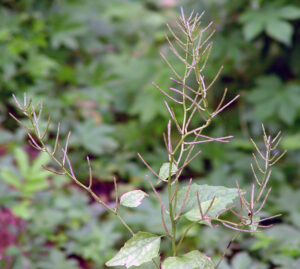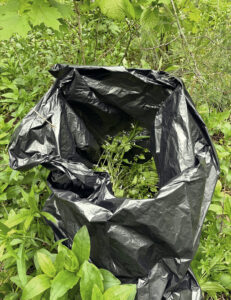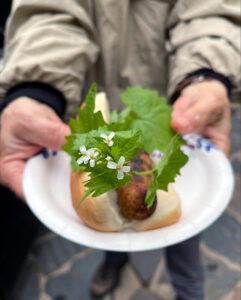By Erika Segerson-Mueller, DNR Invasive Plant Program Specialist, Oshkosh Service Center
Erika.SegersonMueller@wisconsin.gov or 715-492-0391
Summer can be prime time for invasive plant control, with garlic mustard pulls and many other plant- or location-specific events taking place to confront invasive plants head-on.
Wanting to do your best to help, you might pull garlic mustard along your local hiking trail. But what should you do after you pull it?
Read on for invasive plant disposal tips to ensure you don’t inadvertently do more harm than good with your control efforts.

Removing the white, four-petaled flowers of garlic mustard as well as the siliques (long thin, seedpods) is the next-best option if the entire plant cannot be removed. / Photo Credit: Chris Evans, University of Illinois, Bugwood.org
First: Control
Control for each invasive plant can vary, so the best management practice for each species should be investigated before control begins. Some plants are stopped in their tracks by mowing; others resprout aggressively and are actually helped by mowing. Check out the Wisconsin Department of Natural Resources (DNR) invasive species fact sheet pages for control information on specific plants.
Then: Dispose
Now that you’ve pulled, mowed, cut stumps, girdled or treated with herbicide, what comes next?
The proper method for disposal of invasive plant materials varies by the plant type and when in its life cycle it was collected. Plants need to be disposed of properly to ensure that they don’t continue to spread. Some plants continue to develop and can seed even after they have been cut or pulled.
Invasive garlic mustard (Alliaria petiolata) is one such plant. Simply pulling garlic mustard plants and leaving them on the trail, while likely done with the best intentions, isn’t the best solution. The seedpods (siliques) will continue to mature. Seeds can be spread by water, animals or foot traffic, so any garlic mustard plants should be removed from the woods where you found them.
If you can’t remove the entire plant and carry it out with you, the next best option is to remove any flowers and the long, thin seedpods if present.

After pulling, garlic mustard should be bagged and carried out of the woods because its seeds will continue to mature even after it has been pulled.
Bag Or Burn
The two most common methods for invasive plant disposal are to bag or burn the materials. Invasive plant material can usually be processed with your regular garbage. Simply bag any plant material, being sure to tie the bag tightly so seeds or plant fragments cannot escape, and label it “Invasive Plants – Approved by DNR for Landfill.” Labeling is not required, but it may help avoid any issues with your waste management company because all other yard waste is prohibited from entering landfills.
Burning is another method for disposal, though it requires consideration of several factors. Weather conditions and fire warnings should be consulted before burning, as should the plant type. Some plants should not be burned as they can release toxins or irritants into the air that may harm humans or wildlife. Other plants should not be burned as this will cause their seeds to spread even more.
If conditions and the plant type allow, make sure to get a permit before burning if required. Plants should also be allowed to dry fully before burning.
How NOT To Dispose
Leaving garlic mustard on the trails is a bad choice. There are a few other options that might seem like good disposal methods but aren’t effective for invasive plants.
- Composting: While composting is great for kitchen waste and some yard plants, backyard compost piles and bins aren’t a good choice for invasive plant disposal. These types of compost setups (and many municipal compost facilities) do not reliably generate enough heat for long enough. As a result, not all seeds will be destroyed, allowing for the possibility of continued spread.
- Dumping: Dumping yard or plant waste into woods or other natural areas is never a good idea. Although this “green waste” may be biodegradable, yard waste often includes invasive materials (seeds, spores or pests) that can harm these environments and cause new infestations.

A garlic mustard-topped bratwurst is served after a recent garlic mustard pull event near Copper Falls State Park.
Can’t Beat ‘Em? Eat ‘Em
While this is a somewhat less popular option, some invasive plant species are edible. Side note: Remember that under Wisconsin’s Invasive Species Rule NR40, invasive plants cannot be planted or transferred, so don’t start any gardens or crops of invasives for the sole purpose of eating them.
If you are participating in a pull-a-thon or controlling invasive plants in your own woods or backyard, you may be able to try out some new recipes. Garlic mustard can be used as the base for a pesto, eaten raw in small quantities or added to flavor soups and stews.
Avoid eating plants from public-use areas, areas with frequent high traffic of humans and pets or areas where chemical control such as herbicides may have been used. Always know where your plant comes from; even those growing in natural areas may encounter substances that you should not eat. If plants look wilted or sickly, it is best to avoid eating them.
